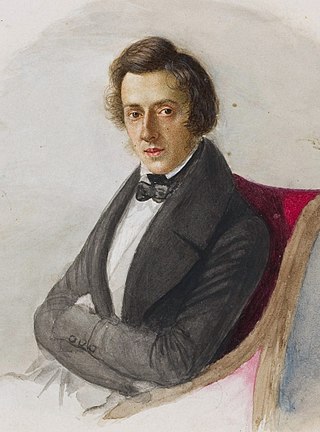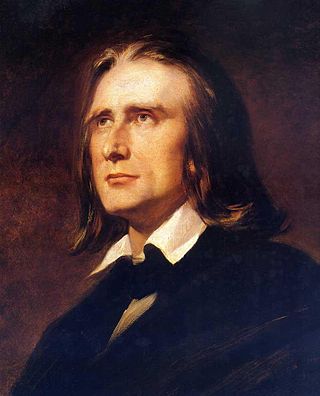
Franz Liszt was a Hungarian composer, virtuoso pianist, conductor and teacher of the Romantic period. With a diverse body of work spanning more than six decades, he is considered to be one of the most prolific and influential composers of his era, and his piano works continue to be widely performed and recorded.

Carl Czerny was an Austrian composer, teacher, and pianist of Czech origin whose music spanned the late Classical and early Romantic eras. His vast musical production amounted to over a thousand works and his books of studies for the piano are still widely used in piano teaching. He was one of Ludwig van Beethoven's best-known pupils and would later on be one of the main teachers of Franz Liszt.

The Piano Concerto in A minor, Op. 16, composed by Edvard Grieg in 1868, was the only concerto Grieg completed. It is one of his most popular works, and is among the most popular of the genre. Grieg, being only 24 years old at the time of the composition, had taken inspiration from Robert Schumann's only concerto, also being in A minor.

The Piano Quintet in E-flat major, Op. 44, by Robert Schumann was composed in 1842 and received its first public performance the following year. Noted for its "extroverted, exuberant" character, Schumann's piano quintet is considered one of his finest compositions and a major work of nineteenth-century chamber music. Composed for piano and string quartet, the work revolutionized the instrumentation and musical character of the piano quintet and established it as a quintessentially Romantic genre.
The Piano Quintet in F minor, Op. 34, by Johannes Brahms was completed during the summer of 1864 and published in 1865. It was dedicated to Her Royal Highness Princess Anna of Hesse. As with most piano quintets composed after Robert Schumann's Piano Quintet (1842), it is written for piano and string quartet.

Friedrich Julius Reubke was a German composer, pianist and organist. In his short life, he composed the Sonata on the 94th Psalm in C minor, which is considered to be one of the greatest organ works in the romantic repertoire.

Karl Tausig was a Polish virtuoso pianist, arranger and composer. He is generally regarded as Franz Liszt's most distinguished pupil and one of the greatest pianists of all time.
Cyclic form is a technique of musical construction, involving multiple sections or movements, in which a theme, melody, or thematic material occurs in more than one movement as a unifying device. Sometimes a theme may occur at the beginning and end ; other times a theme occurs in a different guise in every part.
The "War of the Romantics" is a term used by some music historians to describe the schism among prominent musicians in the second half of the 19th century. Musical structure, the limits of chromatic harmony, and program music versus absolute music were the principal areas of contention. The opposing parties crystallized during the 1850s. The most prominent members of the conservative circle were Johannes Brahms, Joseph Joachim, Clara Schumann, and the Leipzig Conservatoire, which had been founded by Felix Mendelssohn. Their opponents, the radical progressives mainly from Weimar, were represented by Franz Liszt and the members of the so-called New German School, and by Richard Wagner. The controversy was German and Central European in origin; musicians from France, Italy, and Russia were only marginally involved.

The Piano Sonata No. 2 in B♭ minor, Op. 35, is a piano sonata in four movements by Polish composer Frédéric Chopin. Chopin completed the work while living in George Sand's manor in Nohant, some 250 km (160 mi) south of Paris, a year before it was published in 1840. The first of the composer's three mature sonatas, the work is considered to be one of the greatest piano sonatas of the literature.
A Faust Symphony in three character pictures, S.108, or simply the "Faust Symphony", is a choral symphony written by Hungarian composer Franz Liszt inspired by Johann Wolfgang von Goethe's drama, Faust. The symphony was premiered in Weimar on 5 September 1857, for the inauguration of the Goethe–Schiller Monument there.
The Concerto pathétique (S.258/2), completed in 1866, is Franz Liszt's most substantial and ambitious two-piano work. At least three piano concerto arrangements of the work have been made by other composers, based on Liszt's suggestions.
Franz Liszt wrote drafts for his Concerto for Piano and Orchestra No. 2 in A major, S.125, during his virtuoso period, in 1839 to 1840. He then put away the manuscript for a decade. When he returned to the concerto, he revised and scrutinized it repeatedly. The fourth and final period of revision ended in 1861. Liszt dedicated the work to his student Hans von Bronsart, who gave the first performance, with Liszt conducting, in Weimar on January 7, 1857.

Après une lecture du Dante: Fantasia quasi Sonata is a piano sonata in one movement, written by Hungarian composer Franz Liszt in 1849. It was first published in 1856 as part of the second volume of his Années de pèlerinage. This work of program music was inspired by the reading of Victor Hugo's poem “Après une lecture de Dante” (1836).

The symphonic poems of the Hungarian composer Franz Liszt are a series of 13 orchestral works, numbered S.95–107. The first 12 were composed between 1848 and 1858 ; the last, Von der Wiege bis zum Grabe, followed in 1882. These works helped establish the genre of orchestral program music—compositions written to illustrate an extra-musical plan derived from a play, poem, painting or work of nature. They inspired the symphonic poems of Bedřich Smetana, Antonín Dvořák, Richard Strauss and others.

The Fantasy and Fugue on the chorale "Ad nos, ad salutarem undam", S.259, is a piece of organ music composed by Franz Liszt in the winter of 1850 when he was in Weimar. The chorale on which the Fantasy and Fugue is based was from Act I of Giacomo Meyerbeer's opera Le prophète. The work is dedicated to Meyerbeer, and it was given its premiere on October 29, 1852. The revised version was premiered in the Merseburg Cathedral on September 26, 1855, with Alexander Winterberger performing. The whole work was published by Breitkopf & Härtel in 1852, and the fugue was additionally published as the 4th piece of Liszt's operatic fantasy "Illustrations du Prophète" (S.414). A piano duet version by Liszt appeared during the same time (S.624).

Walter Bache was an English pianist and conductor noted for his championing the music of Franz Liszt and other music of the New German School in England. He studied privately with Liszt in Italy from 1863 to 1865, one of the few students allowed to do so, and continued to attend Liszt's master classes in Weimar, Germany regularly until 1885, even after embarking on a solo career. This period of study was unparalleled by any other student of Liszt and led to a particularly close bond between Bache and Liszt. After initial hesitation on the part of English music critics because he was a Liszt pupil, Bache was publicly embraced for his keyboard prowess, even as parts of his repertoire were questioned.
Although Franz Liszt provided opus numbers for some of his earlier works, they are rarely used today. Instead, his works are usually identified using one of two different cataloging schemes:
Double-function form is a musical construction that allows for a collection of movements to be viewed as elements of a single larger musical form. The most famous example of this is Franz Liszt's Piano Sonata in B minor (1853). The sonata is composed as a single movement with about a half an hour's duration. The piece introduces some themes at the very outset of the piece which are manipulated and recapitulated over twenty minutes later. Charles Rosen believes that the work as whole fulfils his criterion for a sonata form. Moreover, within the one long sonata form, there exists a short sonata form, followed by a slow ternary, followed by a scherzo and fugue, followed by a finale. Thus, the single movement fulfills the standard of both a classical sonata form and a classical four movement piano sonata.
The Consolations are a set of six solo piano works by Franz Liszt. The compositions take the musical style of Nocturnes with each having its own distinctive style. Each Consolation is composed in either the key of E major or D♭ major. E major is a key regularly used by Liszt for religious themes.














